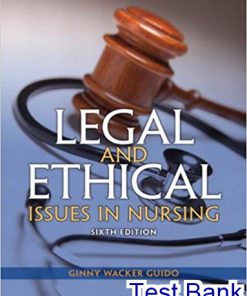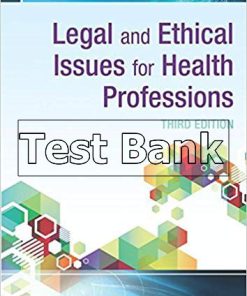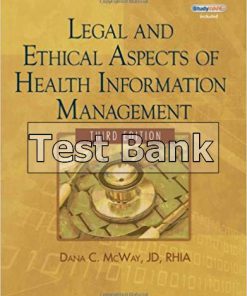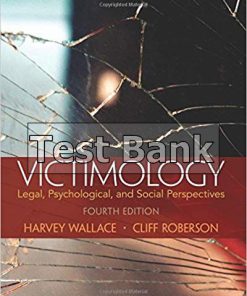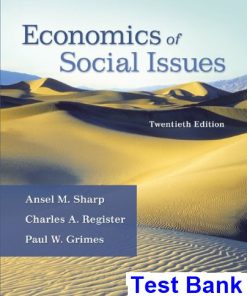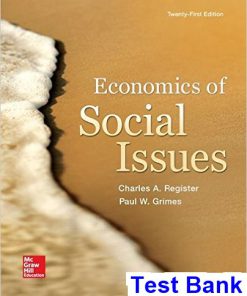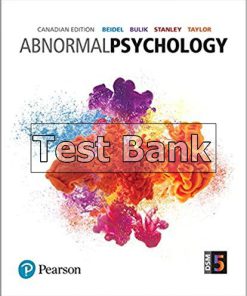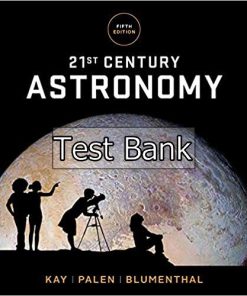Gift of Fire Social Legal and Ethical Issues for Computing Technology 4th Edition Baase Test Bank
$50.00 Original price was: $50.00.$26.50Current price is: $26.50.
Gift of Fire Social Legal and Ethical Issues for Computing Technology 4th Edition Baase Test Bank.
This is completed downloadable of Gift of Fire Social Legal and Ethical Issues for Computing Technology 4th Edition Baase Test Bank
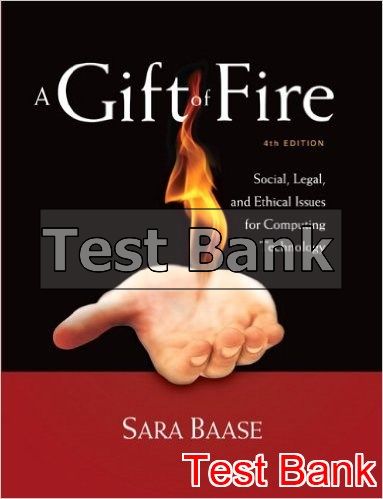
Product Details:
- ISBN-10 : 0132492679
- ISBN-13 : 978-0132492676
- Author: Sara Baase
A Gift of Fire: Social, Legal, and Ethical Issues for Computing Technology, 4e is ideal for courses in Computer Ethics and Computers and Society. It is also a useful reference for computer science professionals or anyone interested in learning more about computing technology and its overarching impact.
Sara Baase explores the social, legal, philosophical, ethical, political, constitutional, and economic implications of computing and the controversies they raise. With a computer scientist’s perspective, and with historical context for many issues, she covers the issues students will face both as members of a technological society and as professionals in computer-related fields. A primary goal is to develop computer professionals who understand the implications of what they create and how it fits into society at large.
Table of Content:
- Unwrapping the Gift
- 1.1 The Pace of Change
- 1.2 Change and Unexpected Developments
- 1.2.1 Self-Driving Vehicles
- 1.2.2 Connections: Mobile Phones, Social Networking, and the Internet of Things
- 1.2.3 E-commerce and Free Stuff
- 1.2.4 Artificial Intelligence, Robotics, Sensors, and Motion
- 1.2.5 Tools for Disabled People
- 1.3 Themes
- 1.4 Ethics
- 1.4.1 What is Ethics, Anyway?
- 1.4.2 A Variety of Ethical Views
- 1.4.3 Some Important Distinctions
- Privacy
- 2.1 Privacy Risks and Principles
- 2.1.1 What Is Privacy?
- 2.1.2 New Technology, New Risks
- 2.1.3 Terminology and Principles for Managing Personal Data
- 2.2 The Business and Social Sectors
- 2.2.1 Marketing and Personalization
- 2.2.2 Our Social and Personal Activity
- 2.2.3 Location Tracking
- 2.2.4 A Right to Be Forgotten
- 2.3 The Fourth Amendment and Changing Technology
- 2.3.1 The Fourth Amendment
- 2.3.2 Background, Law, and Court Decisions
- 2.3.3 Applying the Fourth Amendment in New Areas
- 2.4 Government Systems
- 2.4.1 Video Surveillance and Face Recognition
- 2.4.2 Databases
- 2.4.3 Public Records: Access versus Privacy
- 2.4.4 National ID Systems
- 2.4.5 The NSA and Secret Intelligence Gathering
- 2.5 Protecting Privacy: Technology and Markets
- 2.5.1 Developing Privacy Tools
- 2.5.2 Encryption
- 2.5.3 Blocking Ads
- 2.5.4 Policies for Protecting Personal Data
- 2.6 Protecting Privacy: Theory, Rights, and Laws
- 2.6.1 A Right to Privacy
- 2.6.2 Law and Regulation
- 2.6.3 Contrasting Viewpoints
- 2.7 Privacy Regulations in the European Union
- 2.1 Privacy Risks and Principles
- Freedom of Speech
- 3.1 The First Amendment and Communications Paradigms
- 3.1.1 Free Speech Principles
- 3.1.2 Regulating Communications Media
- 3.2 Controlling Speech in Cyberspace
- 3.2.1 What Is O ensive Speech? What Is Illegal?
- 3.2.2 Censorship Laws and Alternatives
- 3.2.3 Child Pornography and Sexting
- 3.2.4 Spam
- 3.2.5 Challenging Old Regulatory Structures and Special Interests
- 3.3 Decisions about Legal but Objectionable Content
- 3.4 Leaking Sensitive Material
- 3.5 Anonymity
- 3.6 The Global Net: Censorship and Political Freedom
- 3.6.1 Tools for Communication, Tools for Oppression
- 3.6.2 Aiding Foreign Censors and Repressive Regimes
- 3.6.3 Shutting Down Communications in Free Countries
- 3.7 Net Neutrality: Regulations or the Market?
- 3.1 The First Amendment and Communications Paradigms
- Intellectual Property
- 4.1 Principles and Laws
- 4.1.1 What Is Intellectual Property?
- 4.1.2 Challenges of New Technologies
- 4.1.3 A Bit of History
- 4.1.4 The Fair Use Doctrine
- 4.1.5 Ethical Arguments About Copying
- 4.2 Signi cant Fair Use Cases and Precedents
- 4.2.1 Sony v. Universal City Studios (1984)
- 4.2.2 Reverse Engineering: Game Machines
- 4.2.3 Sharing Music: The Napster and Grokster Cases
- 4.2.4 User and Programmer Interfaces
- 4.3 Responses to Copyright Infringement
- 4.3.1 Defensive and Aggressive Responses from the Content Industries
- 4.3.2 The Digital Millennium Copyright Act: Anti Circumvention
- 4.3.3 The Digital Millennium Copyright Act: Safe Harbor
- 4.3.4 Evolving Business Models
- 4.4 Search Engines and Online Libraries
- 4.5 Free Software
- 4.5.1 What Is Free Software?
- 4.5.2 Should All Software Be Free?
- 4.6 Patents for Software Inventions
- 4.6.1 Patent Trends, Confusion, and Controversies
- 4.6.2 To Patent or Not?
- 4.1 Principles and Laws
- Crime and Security
- 5.1 Introduction
- 5.2 What is Hacking?
- 5.2.1 The Evolution of Hacking
- 5.2.2 Hacker Tools
- 5.2.3 Is “Harmless” Hacking Harmless?
- 5.3 Some Speci c Applications of Hacking
- 5.3.1 Identity Theft
- 5.3.2 Case Study: The Target Breach
- 5.3.3 Hacktivism, or Political Hacking
- 5.3.4 Hacking by Governments
- 5.4 Why Is the Digital World So Vulnerable?
- 5.4.1 Vulnerability of Operating Systems and the Internet
- 5.4.2 Human Nature, Markets, and Vulnerability of the Internet of Things
- 5.5 Security
- 5.5.1 Tools to Help Protect the Digital World
- 5.5.2 People Who Can Help Protect the Digital World
- 5.5.3 Hacking to Improve Security
- 5.5.4 Backdoors for Law Enforcement
- 5.6 The Law
- 5.6.1 The Computer Fraud and Abuse Act
- 5.6.2 Criminalize Virus Writing and Hacker Tools?
- 5.6.3 Penalties for Young Hackers
- 5.7 Whose Laws Rule the Web?
- 5.7.1 A Crime in One Country but Not Another
- 5.7.2 Libel and Freedom of Speech
- 5.7.3 Culture, Law, and Ethics
- 5.7.4 Potential Solutions
- Work
- 6.1 Fears and Questions
- 6.2 Impacts on Employment
- 6.2.1 Job Destruction and Creation
- 6.2.2 Changing Skills and Skill Levels
- 6.2.3 Are We Earning Less and Working More?
- 6.3 Changing Work Patterns: From Telecommuting to Gigs
- 6.3.1 Telecommuting
- 6.3.2 The Sharing Economy, On-Demand Services, and GIG Work
- 6.4 A Global Workforce
- 6.5 Employee Communication and Monitoring by Employers
- 6.5.1 Social Media Content
- 6.5.2 Separating–or Merging–Work and Personal Systems
- 6.5.3 Monitoring Employer Systems and Tracking Employees
- Evaluating and Controlling Technology
- 7.1 Evaluating Information
- 7.1.1 The Need for Responsible Judgment
- 7.1.2 Computer Models
- 7.2 Neo-Luddite Views of Computers, Technology, and Quality of Life
- 7.2.1 Criticisms of Computing Technologies
- 7.2.2 Views of Economics, Nature, and Human Needs
- 7.3 Digital Divides
- 7.3.1 Trends in Access in the United States
- 7.3.2 Reaching the Next Billion Users
- 7.4 Control of Our Devices and Data
- 7.4.1 Remote Deletion of Software and Data
- 7.4.2 Automatic Software Upgrades
- 7.5 Making Decisions About Technology
- 7.5.1 Questions
- 7.5.2 The Di culty of Prediction
- 7.5.3 Intelligent Machines and Super-intelligent Humans–Or the End of the Human Race?
- 7.5.4 A Few Observations
- 7.1 Evaluating Information
- Errors, Failures, and Risks
- 8.1 Failures and Errors in Computer Systems
- 8.1.1 An Overview
- 8.1.2 Problems For Individuals
- 8.1.3 System Failures
- 8.1.4 Example: Stalled Airports at Denver, Hong Kong, and Malaysia
- 8.1.5 Example: HealthCare.gov
- 8.1.6 What Goes Wrong?
- 8.1.7 Problems For Individuals
- 8.2 Case Study:The Therac-25
- 8.2.1 Therac-25 Radiation Overdoses
- 8.2.2 Software and Design Problems
- 8.2.3 Why So Many Incidents?
- 8.2.4 Observations and Perspective
- 8.3 Increasing Reliability and Safety
- 8.3.1 Professional Techniques
- 8.3.2 Trust the Human or the Computer System?
- 8.3.3 Law, Regulation, and Markets
- 8.4 Dependence, Risk, and Progress
- 8.4.1 Are We Too Dependent on Computers?
- 8.4.2 Risk and Progress
- 8.1 Failures and Errors in Computer Systems
- Professional Ethics and Responsibilities
- 9.1 What Is “Professional Ethics”?
- 9.2 Ethical Guidelines for Computer Professionals
- 9.2.1 Special Aspects of Professional Ethics
- 9.2.2 Professional Codes of Ethics
- 9.2.3 Guidelines and Professional Responsibilities
- 9.3 Scenarios
- 9.3.1 Introduction and Methodology
- 9.3.2 Protecting Personal Data
- 9.3.3 Designing an Application with Targeted Ads
- 9.3.4 Webcams in School Laptops
- 9.3.5 Publishing Security Vulnerabilities
- 9.3.6 Specifications
- 9.3.7 Schedule Pressures
- 9.3.8 Software License Violation
- 9.3.9 Going Public with Safety Concerns
- 9.3.10 Release of Personal Information
- 9.3.11 Conflict of Interest
- 9.3.12 Kickbacks and Disclosure
- 9.3.13 A Test Plan
- 9.3.14 Artificial Intelligence and Sentencing Criminals
- 9.3.15 A Gracious Host
Epilogue
The Software Engineering Code and the ACM Code
A.1. Software Engineering Code of Ethics and Professional Practice
A.2. ACM Code of Ethics and Professional Conduct
Index
People Also Search:
gift of fire social legal and ethical issues for computing technology baase
gift of fire social legal and ethical issues for computing technology 4th edition baase
gift of fire social legal and ethical issues for computing technology
gift of fire social legal and ethical issues for computing technology 4th edition testbank download pdf
baase gift of fire social legal and ethical issues for computing technology pdf
gift of fire social legal and ethical issues for computing technology 4th edition download scribd
gift of fire social legal and ethical issues for computing technology 4th edition
Instant download after Payment is complete
You may also like…
Solutions Manual
Legal and Ethical Aspects of Health Information Management 3rd Edition McWay Test Bank
Solutions Manual
Victimology Legal Psychological and Social Perspectives 4th Edition Wallace Test Bank
Related products
Test Bank




